The Guernica Tree (1975)
Directed by: Fernando Arrabal
Written by: Fernando Barreda Luna
Starring: Cosimo Cinieri, Mariangela Melato, Ron Faber
A week later than intended, Doc looks at the third and final film of the first of Cult Epics’s two Fernando Arrabal box sets.
HCF REWIND NO.60 THE GUERNICA TREE AKA L’ARBRE DE GUERNICA [France, 1975]
AVAILABLE ON DVD: From Cult Epics
RUNNING TIME: 110 mins
REVIEWED BY: Dr Lenera, Official HCF Critic
Spain, 1936, just before the Spanish Civil War tore apart the nation. The town of Villa Romero is ruled by Count Cerralbo and his four sons, three of whom are equally as nasty and money-hungry as their father. When a woman called Vandale arrives in the town, they try to rape her but Vandale throws snakes in their faces. The black sheep of the family is Goya, a libertarian and an anarchist who delights in playing pranks, and who is also against his father and brothers treatment of the peasant population. Goya’s brothers join the fascist army to help overthrow the Republican government, and the war begins all over the country. Pacifist Goya is torn over what to do and where his loyalties lie………
Viva La Muerte and I Will Walk Like A Crazy Horse, while certainly commenting on aspects of society, concentrated on the plight of individuals. The Guernica Tree widens its scope to show the plight of a nation. As with all nations which suffer from a civil war, Spain was wrecked by the conflict and Fernando Arrabal’s childhood memories of the horrors obviously fed into The Guernica Tree, though it’s a less obviously autobiographical than Viva La Muerte. A devastating attack on war and a lament for the countries it ruins, The Guernica Tree is to me the best of the three Arrabal films that make up the first of Cult Epics’s two box sets. It’s a passionate, powerful picture whose messages are universal and I can’t believe for the life of me why it isn’t well known and its distribution was so limited. And in case you ask, there is still much surrealistic weirdness and shocking imagery, though overall it’s more classical in style and feel than his first two movies.
The inspiration for The Guernica Tree, as anyone who knows about art will have probably deduced, is a certain event that took place in 1937 and led to a painting called Guernica by Pablo Picasso. Planes from Nazi Germany, which was supporting the Fascist rebels, levelled the town of Guernica but somehow failed to damage a certain tree in the centre of the town, a tree which became famous and was thereafter called the Freedom Tree. The symbolism inherent in such an event is striking though Arrabal, rather than film a straight version of the story, decided to set most of his tale in a nearby ficticious village called Villa Romero and use the bombing of Guernica just as a short centrepiece. Villa Romero becomes a sort of microcosm of Spain and it’s a device that Arrabal uses superbly, really conveying what happened while scaling it down.
Arrabal nicely sets up the seeds of the conflict. The town is ruled over by the heartless, cruel Count, while the townsfolk seems to while away their time dancing in the streets, either oblivious to the town’s plight or trying to deal with it. The time seems ripe for an uprising, though of course the Fascists, very much cartoonlike caricatures but that is the point, are far nastier than the tyrannical landowners, corrupt clergymen and weak military that make up most of the Republican side. Arrabal likes to use metaphors to set us up for the violence ahead, such as the attack on Vandale which initially seemed to me a little unnecessary. And of course we are still treated to bizarre surreal imagery, with the first ten minutes treating us to people pushing a giant knife with enormous ears along the ground, a dwarf having sex with a woman while other dwarves watch, and a whole barrage of sacrilegious happenings as we are shown what our ‘hero’ Goya, whose name is one of many references to art and perhaps could also be called Fernando Arrabal, likes to get up to, including cries that church communion is poisoned during a mass and a painting where Jesus is receiving a blow job.
There is no doubt whatsoever that Arrabal has not lost any of his edge – this particular outing really viciously attacks the Church throughout and devout Christians will find much to offend them – but this kind of stuff is almost pushed into the background when the war gets underway. Making the most of his low budget, Arrabal depicts much of the conflict with real black and white footage, which initially jars a little but ends up hammering home that these events really happened, and the cutting throughout is designed for maximum impact. A shot of a guy being bloodily shot by a firing squad is followed by a shot of lots of real dead victims of firing squads. As the war eventually arrives in Villa Romero, Arrabal does give us some ‘staged’ action and it’s certainly convincing enough. The final section of the film reminded me of Salo and gives us one of the most memorable images I’ve seen in ages; that of a man pushing a tied down dwarf around on a cart at a bullfighter, though it’s almost matched by the shot of a young boy innocently playing with a skull in a cave full of skulls.
The characters are all deliberately archetypal. Arrabal depicts the Fascists as truly horrible, but the hippie-like, almost ignorant idealists on the other side are hardly wonderful. War is all-encompassing; it may be an awful thing, but if it comes up there is no getting away from having to choose a side. The Guernica Tree does have some positivity about humanity though. The love story, which begins with a deliberately corny ‘love at first sight’ moment, has the minimum amount of time spent on it but is the matter upon which the film ends. Does Arrabal believe in the supposed strength of love, love as a possible redemption, or is he just taking the mickey out of the usual cliches? Who knows? Whatever, the movie ends with a beautiful shot by cinematographer Ramom Suarez, whose work throughout is sumptuous and elegant, especially when he zooms into and away from people’s eyes to emotional impact.
The Guernica Tree has some slightly better known performers than before and they all fare well, though I noticed I Will Walk Like A Crazy Horse’s Hachemi Marzouk as a dwarf too, and the movie still has some of that typical Arrabal feel of improvisation. As with some other elements like the surrealism and the gore it’s restrained somewhat [there are a great many penises though!]. Certain bits where he seems to baiting the audience, as if he feels he still has to, perhaps get a little wearing in context, and it seems that the dwarves in the film are mostly there for Arrabal to do just that. Overall though The Guernica Tree seems to me to be a very fine achievement; it combines the craziness and energy of Arrabal’s first two films with more conventional filmmaking including even some solid storytelling, without losing any passion. Heartfelt and wrenching, it’s one of the best anti-war films I’ve seen in ages.
Rating: 









The DVD release of I Will Walk Like A Crazy Horse from Cult Epics includes:
*New digital transfer
*Interview with Fernando Arrabal
*lobbycard gallery
*Theatrical trailer
*6-page linear notes
It is also available as part of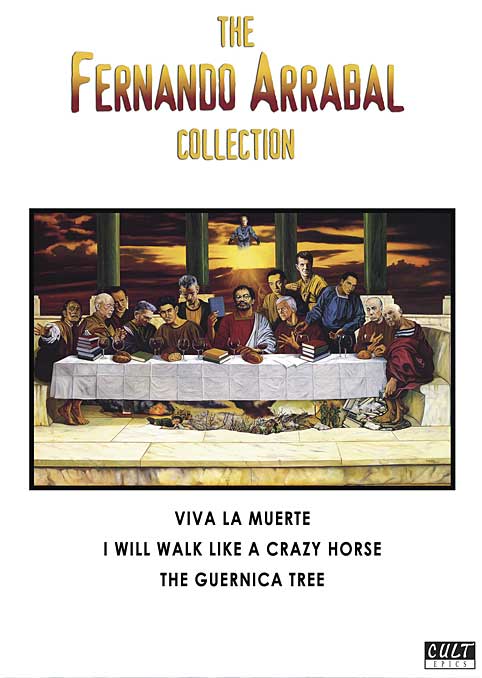
Check out Cult Epics’s site at



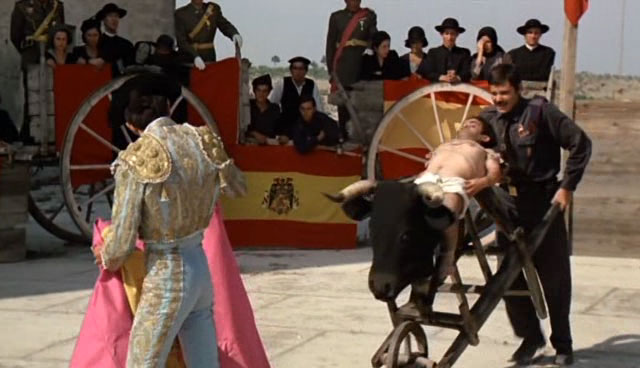

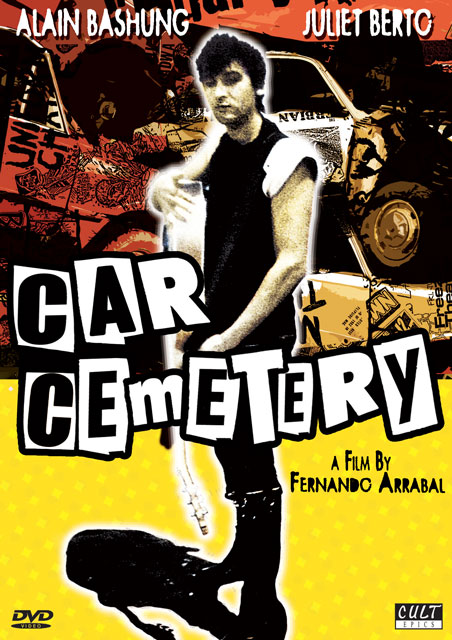
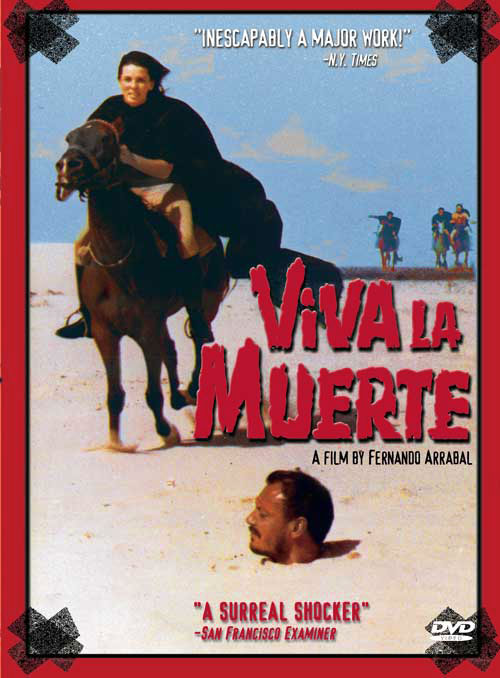
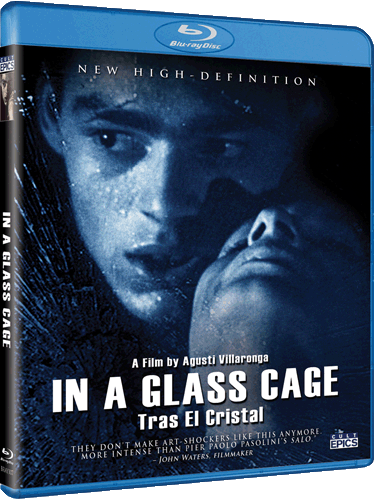
Be the first to comment